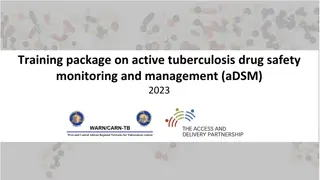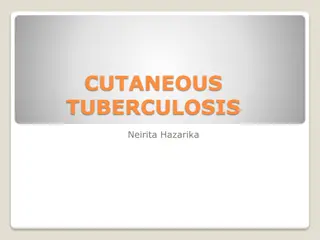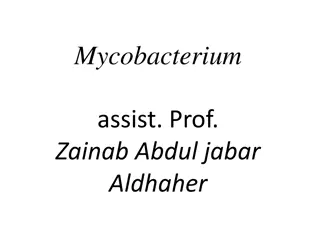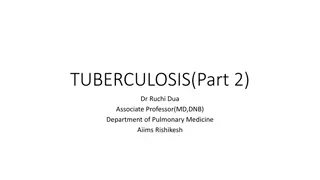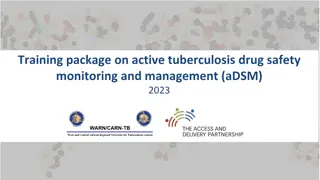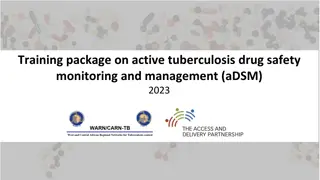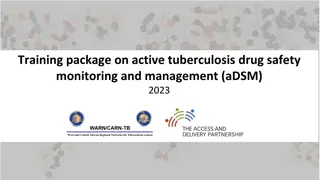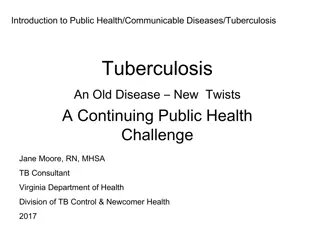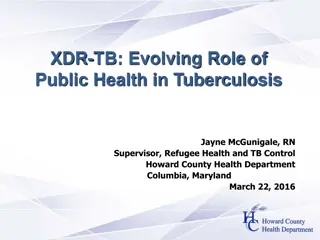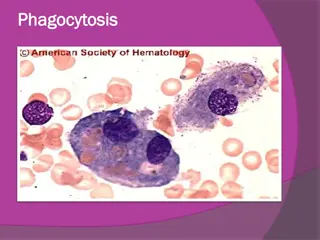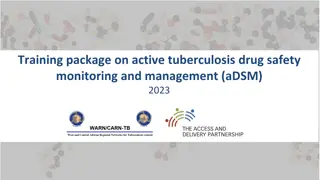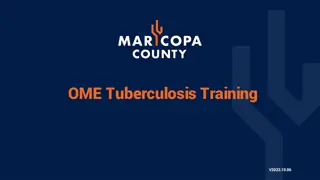Best Practices for Active Tuberculosis Drug Safety Monitoring and Documentation
This training package emphasizes the importance of methodical documentation and quality assurance in the management of active tuberculosis drug safety. Participants will learn about data quality elements, continuous quality improvement, and best practices for documentation in drug safety monitoring. Source documentation should follow the ALCOA principles and include various records like adverse event forms, treatment cards, and laboratory results. Effective documentation ensures accurate recording of events, facilitates information sharing, and supports patient safety.
Download Presentation

Please find below an Image/Link to download the presentation.
The content on the website is provided AS IS for your information and personal use only. It may not be sold, licensed, or shared on other websites without obtaining consent from the author. Download presentation by click this link. If you encounter any issues during the download, it is possible that the publisher has removed the file from their server.
E N D
Presentation Transcript
Training package on active tuberculosis drug safety monitoring and management (aDSM) 2023
2.4. Records Management & Quality Assurance of Data
Learning objectives By the end of this presentation, the participant is expected to be able to: 1. Recognize the importance of methodical and organized documentation 2. Describe fundamental elements of data quality 3. Define continuous quality improvement and how it applies to medical records
Documentation Practices (1) In drug safety monitoring and management, the accurate recording of the details of an event and the action taken is crucial If these details are not documented, then the episode is as good as if it did not happen! The knowledge and lessons learnt will be lost The details need to be recorded in a standardized manner Remember they need to be used by someone else They should be recorded in a way to minimize misunderstandings, allow duplicate reports to be identified, allow pooling
Documentation Practices (2) Source documentation should be ALCOA : Attributable It should be clear who has documented the data Legible Readable and signatures identifiable Contemporaneous The information should be documented in the correct time frame along with the flow of events If a clinical observation cannot be entered when made, chronology should be recorded Acceptable amount of delay should be defined and justified
Documentation Practices (3) Source documentation should be ALCOA : Attributable Legible Contemporaneous Original Original, if not original should be exact copy; the first record made by the appropriate person Accurate Accurate, consistent and real representation of facts
Documentation Practices (4) examples of source documents Adverse Event Form TB treatment card, registers, medical records created during treatment Laboratory results, ECG, audiogram, X-ray, etc. Medical records supplied by the patient Informed Consent Forms Correspondence (email )
Documentation Practices (5) common problems Missing data/documentation Missing dates No attribution Missing subject identifiers Non standard recording of variables Inaccurate/erroneous transcription of values Corrections (white out, scribbling) Illegible Use of checklists (in place of notes)
Documentation Practices (6) ALL records should be: Dated Signed/Attributed Secured Sign/initial and date entries at the time they are made Data entries must be dated on the date of entry contemporaneous Data entries must be signed or initialed by the person entering the data attribution Never sign anybody else s name falsification Do not post- or pre-date
Documentation Practices (7) When records need correction Do not obliterate previous data Date the change Identify the person making the change State reason for the change Do not use whiteout Do not change data without knowledge that the change is correct
Documentation Practices (8) correction techniques Correct Technique Case Report Form Question 2f. Yes or No Y YAK AK 15 Mar 15 15 Mar 15 N Renal function testing conducted prior to starting treatment Incorrect Technique Case Report Form Question 2f. Yes or No N Renal function testing conducted prior to starting treatment obliterating, not initialed
Documentation Practices (9) Not a problem we keep everything on computers ! Requirements for electronic records At least as secure as paper records As for paper records: keep safe from fire, water/humidity, theft of hardware Maintain data security and integrity Controlled access Reliable, validated, adapted software Ability to copy, backup and retrieve Time stamped audit trails Staff training Standard Operation Procedures
Electronic data systems WHO/HTM/TB/2011.22 Adopting electronic recording and reporting is not simply about choosing a piece of software: it is also about changing how people work. This is not a simple undertaking. This document indicates key questions to be considered and illustrates what the questions, options and recommendations mean in practice by drawing on examples of recent experience from a variety of countries. It is useful for those planning to introduce electronic recording and reporting systems for TB care and control, or to enhance existing systems whqlibdoc.who.int/publi cations/2012/97892415 64465_eng.pdf https://apps.who.int/iris/bitstream/han dle/10665/259832/9789241513456eng. pdf?sequence=1&isAllowed=y
Continuous quality improvement (CQI) - (1) basics of data quality assurance Medical record review should include careful training and quality assurance methods to enhance the reliability and validity of data obtained from the records Because of time and budget constraints, comprehensive assessments of data quality and reliability are not always possible Measures are taken when planning systems, entering data, reviewing them, handling and analyzing them to guarantee quality
Continuous quality improvement (CQI) - (2) A quality management process that encourages all health care team members to continuously ask the questions, How are we doing? and Can we do it better? (Edwards, 2008)
Continuous quality improvement (CQI) - (3) Documentation of patient care should be one of the many functions addressed in CQI efforts CQI efforts in the programmatic management of drug- resistant TB should include the development of quality indicators that can be used to evaluate health care provider documentation practices
Continuous quality improvement (CQI) - (4) Other CQI efforts might analyze and improve system-wide policies and procedures for documenting medication use, adverse events and their management Periodic review of organizational policies and procedures will allow for their revision in response to changes in health care and advances in technology, including the availability of an electronic medical records
Conclusion (1) All TB drug safety related documentation - paper and electronic - should be organized, identified and retained so that it can be accurately interpreted without benefit of an interpreter Can I reconstruct what happened? Can I identify who did what and when? Am I confident in the accuracy and authenticity of the data? Without the documentation, there is no evidence for decision making
Conclusion (2) The documentation should narrate the medical journey of the patient as it happened to an independent observer and thus form a strong foundation for good drug safety monitoring and management practices Data quality assurance should be a continuous, inbuilt process at different stages to allow users to understand how their performance is doing and how it can be improved
Acknowledgements The development of the aDSM training material was funded by TDR as part of the Access and Delivery Partnership (ADP) with funding from the Government of Japan. These training materials were put together in 2016 the WHO Task Force on aDSM with technical partners KNCV Tuberculosis Foundation, Management Sciences for Health (SIAPS), MSF, WHO GTB, and TDR. The materials were updated in 2022-23 by Mahamadou Bassirou Souleymane (TDR consultant) with Marie-Eve Raguenaud (TDR), Branwen J Hennig (TDR), and Corinne Merle (TDR), and reviewed by Linh Nhat Nguyen (WHO/GTB), Medea Gegia (WHO/GTB), and Fuad Mirzayev (WHO/GTB). We thank all members of the WARN/CARN-TB working group on aDSM who contributed to the development of the aDSM generic guidelines as well as the secretariat, particularly Dr Christ Houessinon: Disadidi Ambrioso, Esse Marius, Adomou Jamal Rouamba Ruffine, Haro Sougrimani, Koumbem Boureima, Nsanzerugeze Jos lyne, Tollo Tollo Daniel Alphonse D sir , Mpaba Minkat Th ophile Mistral, Julie Abessolo, Ursule IDOKO, Tijan Baldeh , Wandifa Samateh, Tida S Kinteh, Alieu Wurie, Mardemn Yeasuen, Benjamin K. Quenneh, Cheick Oumar Bah, Kane El Hadj Malick, Aw Idriss, Mamoudou Hama Rachida, Gagara I. M. Assiatou, Katamb Balkissa, Seiyabatou ElhSaidou, Liombo Anastasie, Lunganyu Junior, Kitambala Sentime, Lula Yves , Habimana-Mucyo Yves, Migambi Patrick, dos Santos Brigite, Castro V nia, Wadson Cruz, Gueye Aminata, Mukeh Fahnbulleh, Bailor Samuel, Manjo Lamin, Saleh Mahareb Abdoulaye, Haroun Saleh Naima, Mouhoudine Yerima, Kpelafia Silifa



